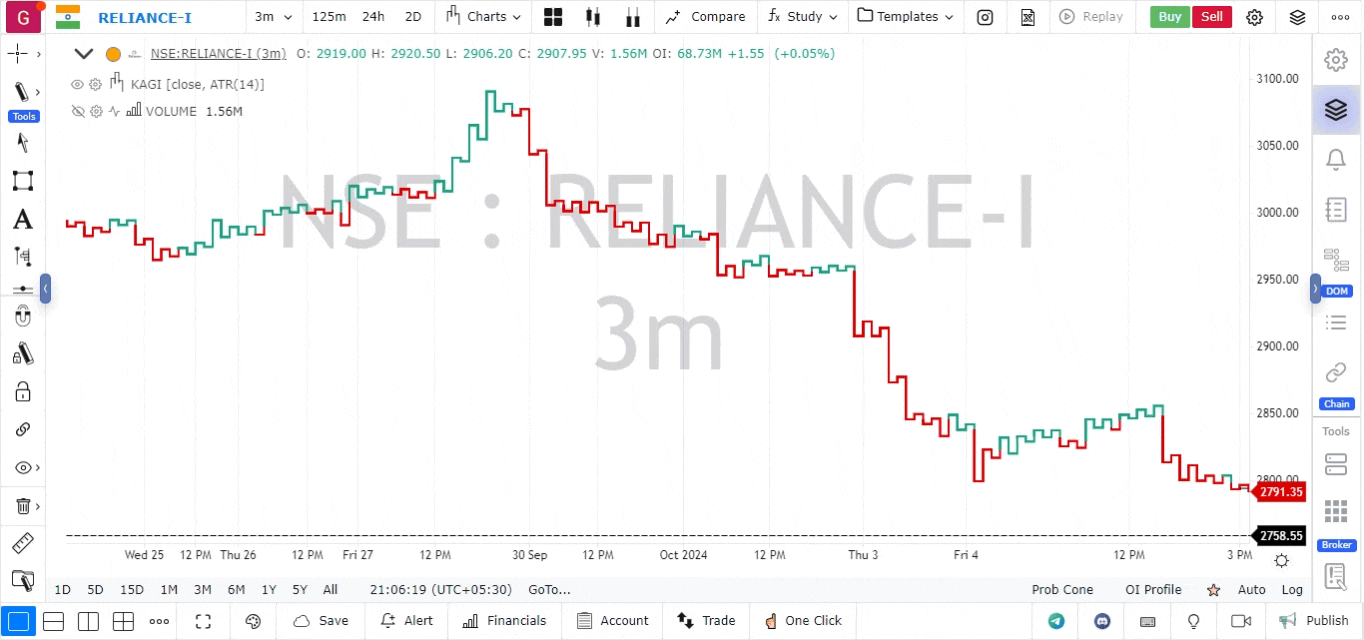Heiken Ashi
General info
Heiken-Ashi chart (HA) is a modified type of classic candlestick chart, which is based on recalculation of OHLC data. The resulting candlestick filters out some noise in an effort to better capture the trend and reversal points.

General view of Heiken-Ashi chart type
The following calculations are used to construct the HA chart:
- HA Close = (O+H+L+C)/4
- HA Open = (HA Open (previous bar) + HA Close(previous bar))/2
- HA High = Maximum (H, HA Open, HA Close)
- HA Low = Minimum (L, HA Open, HA Close)
How to Calculate Heikin-Ashi
- Use one period to create the first Heikin-Ashi (HA) candle, using the formulas. For example use the high, low, open, and close to create the first HA close price. Use the open and close to create the first HA open. The high of the period will be the first HA high, and the low will be the first HA low.
- With the first HA calculated, it is now possible to continue computing the HA candles per the formulas.
- To calculate the next close, use the open, high, low, and close from that period.
- To calculate the next open, use the prior open and prior close.
- To calculate the next high, choose the max of the current period’s high, or the current period’s HA open or close.
- To calculate the next low, choose the max of the current period’s low, or the current period’s HA open or close.
- For steps five and six remember that the HA open and close are not the same as the period’s open and close. The HA open and close were calculated in steps three and four.
What Does Heikin-Ashi Tell You?
The Heikin-Ashi technique is used by technical traders to identify a given trend more easily. Hollow white (or green) candles with no lower shadows are used to signal a strong uptrend, while filled black (or red) candles with no upper shadow are used to identify a strong downtrend. Reversal candlesticks using the Heikin-Ashi technique are similar to traditional candlestick reversal patterns; they have small bodies and long upper and lower shadows. There are no gaps on a Heikin-Ashi chart as the current candle is calculated using information from the previous candle.
Because the Heikin-Ashi technique smooths price information over two periods, it makes trends, price patterns, and reversal points easier to spot. Candles on a traditional candlestick chart frequently change from up to down, which can make them difficult to interpret. Heikin-Ashi charts typically have more consecutive colored candles, helping traders to identify past price movements
The Heikin-Ashi technique reduces noise in sideways and choppy markets to help traders avoid placing trades during these times. For example, instead of getting two false reversal candles before a trend commences, a trader who uses the Heikin-Ashi technique is likely only to receive the valid signal.
KEY TAKEAWAYS
- The averaged open and close help filter some of the market noise, creating a chart that tends to highlight the trend direction better than typical candlestick charts.
- The downside is that some price data is lost with averaging. The most recent price (close) may not reflect the actual price of the asset, which could affect risk.
- Long down candles with little upper shadow represent strong selling pressure. Long up candles with small or no lower shadows signal strong buying pressure.
The Difference Between Heikin-Ashi and Renko Charts
Heikin-Ashi charts are constructed based on averages over two periods. Renko Charts are created by only showing movements of a certain size. While a renko chart has a time axis, the boxes or bricks are not governed by time, only by movement. While a new HA candle will form every period, a renko chart will only produce a new brick/box when the price has moved a certain amount.
Limitations of the Heikin-Ashi Technique
Since the Heikin-Ashi technique uses price information from two periods, a trade setup takes longer to develop. Usually, this is not an issue for swing traders who have time to let their trades play out. However, day traders who need to exploit quick price moves may find Heikin-Ashi charts are not responsive enough to be useful.
The averaged data also obscures important price information. Daily closing prices are considered important by many traders, yet the actual daily closing price is not seen on a Heikin-Ashi chart. The trader only sees the averaged HA closing value. In order to control risk, it is important the trader is aware of the actual price, and not just the HA averaged values.
Also, there are no price gaps. This is another important element in technical analysis which is missing from Heikin-Ashi charts. Many traders use gaps for analyzing price momentum, setting stip loss levels, or triggering entries.